Analyzing Sustainable Marketing Strategies: The MATTER Fashion Brand
VerifiedAdded on 2019/09/26
|17
|4073
|159
Report
AI Summary
This report analyzes the sustainable marketing practices of MATTER, a Singapore-based fashion brand. It explores MATTER's commitment to the triple bottom line framework (environmental, financial, and social) within the fashion industry. The report examines the company's approach to ethical production, eco-friendly materials, and supply chain management. It also discusses the impact of sustainability issues on the brand and the business environment factors driving the need for sustainable marketing. The analysis covers MATTER's strategies for engaging with customers, managing sustainability within the organization, and the potential benefits of these practices. The report emphasizes the importance of sustainable segmentation and the influence of social, individual, and situational factors on consumer behavior within the context of MATTER's operations. The report also explores MATTER's efforts to reduce waste, improve energy efficiency, and promote water conservation.
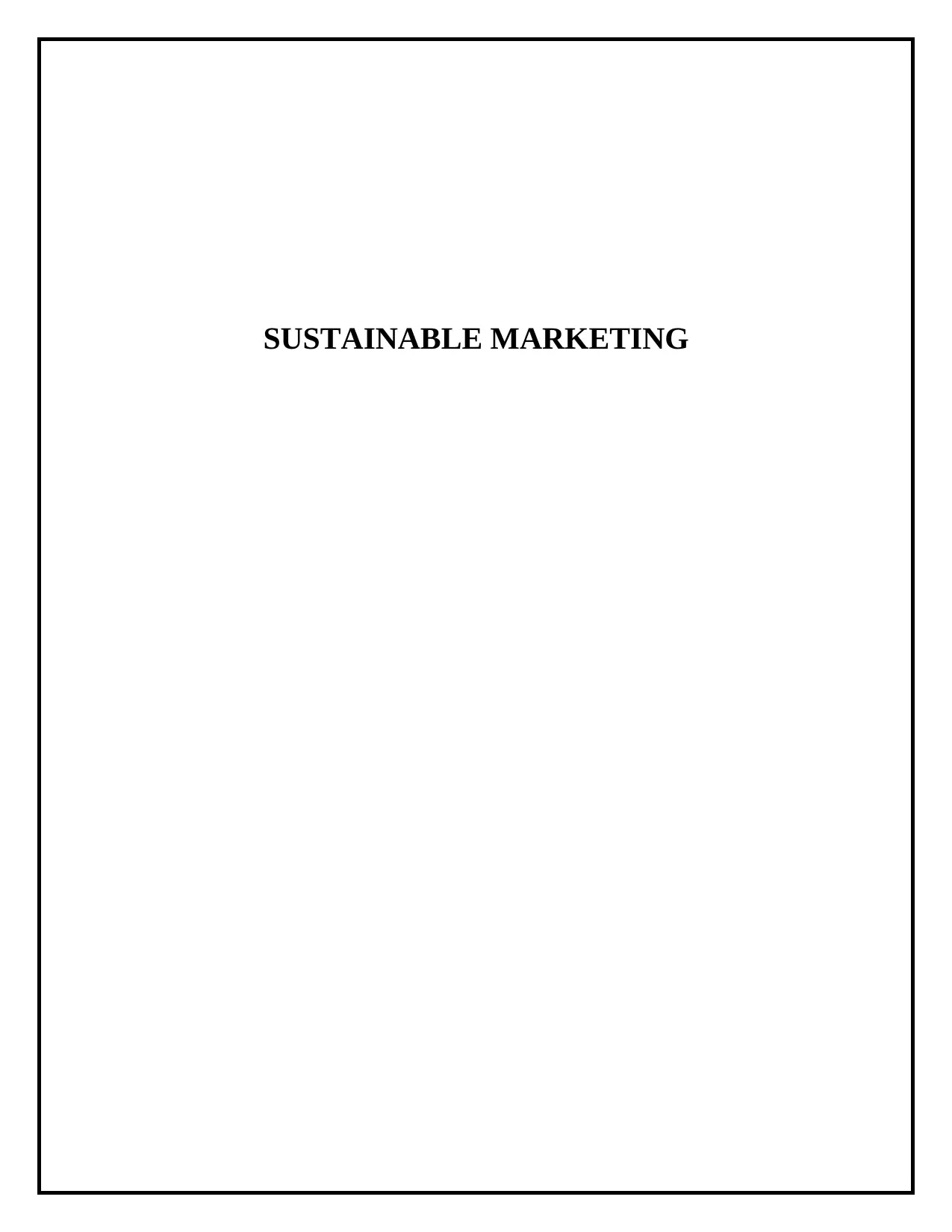
SUSTAINABLE MARKETING
Paraphrase This Document
Need a fresh take? Get an instant paraphrase of this document with our AI Paraphraser

Executive Summary
In this particular study we have discussed about the fashion brand namely MATTER
which is one of the renowned street fashion of Singapore. One of the main motives
conducting this study was to show the meani.ing and sustainability of the sustainability
within the fashion industry segment for which we have selected MATTER. Through this
study it has also been identified that the company is providing focal point on using the
triple bottom line framework from which they are mainly considering the three factors
which are:
Environment
Financial
Social
In this particular study we have discussed about the fashion brand namely MATTER
which is one of the renowned street fashion of Singapore. One of the main motives
conducting this study was to show the meani.ing and sustainability of the sustainability
within the fashion industry segment for which we have selected MATTER. Through this
study it has also been identified that the company is providing focal point on using the
triple bottom line framework from which they are mainly considering the three factors
which are:
Environment
Financial
Social

⊘ This is a preview!⊘
Do you want full access?
Subscribe today to unlock all pages.

Trusted by 1+ million students worldwide
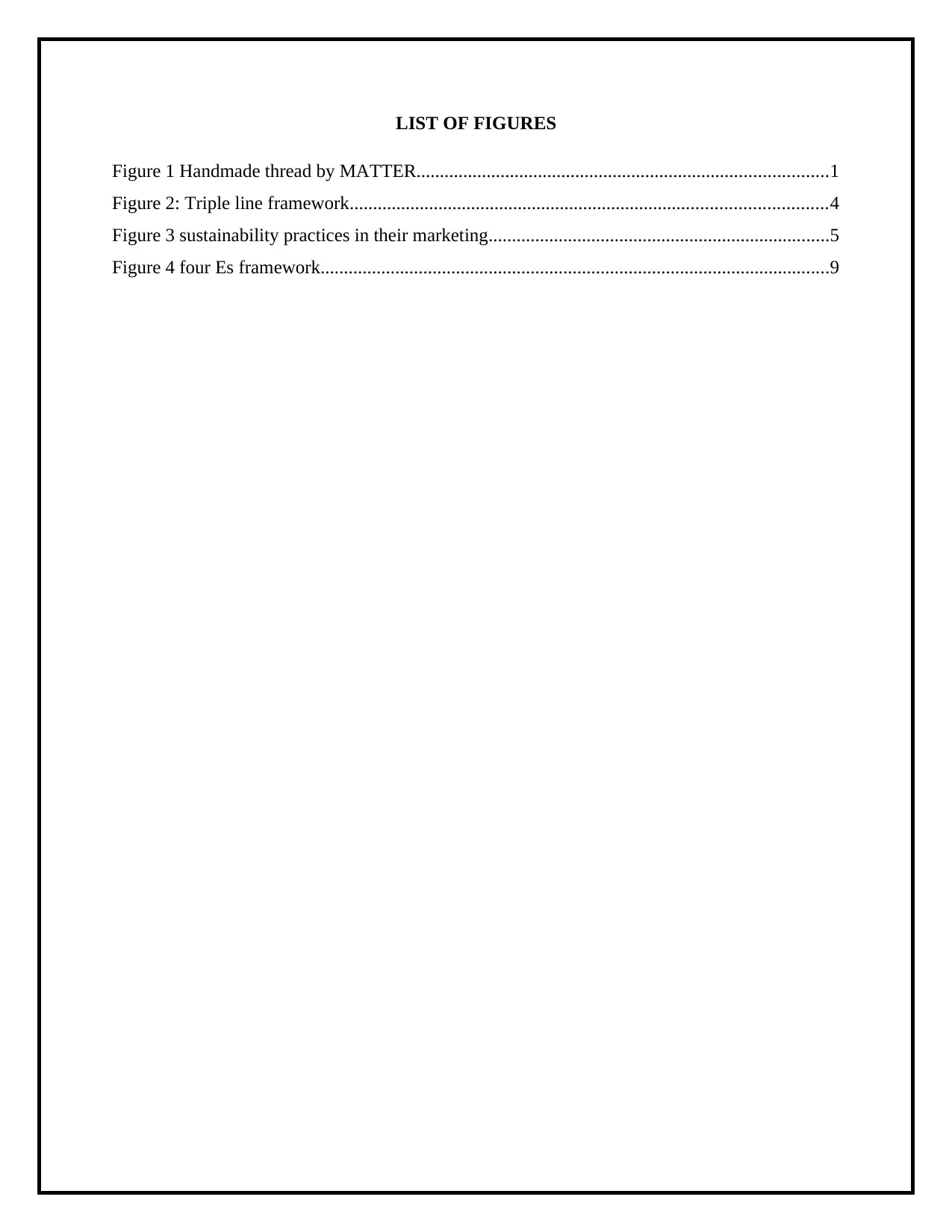
LIST OF FIGURES
Figure 1 Handmade thread by MATTER........................................................................................1
Figure 2: Triple line framework......................................................................................................4
Figure 3 sustainability practices in their marketing.........................................................................5
Figure 4 four Es framework.............................................................................................................9
Figure 1 Handmade thread by MATTER........................................................................................1
Figure 2: Triple line framework......................................................................................................4
Figure 3 sustainability practices in their marketing.........................................................................5
Figure 4 four Es framework.............................................................................................................9
Paraphrase This Document
Need a fresh take? Get an instant paraphrase of this document with our AI Paraphraser
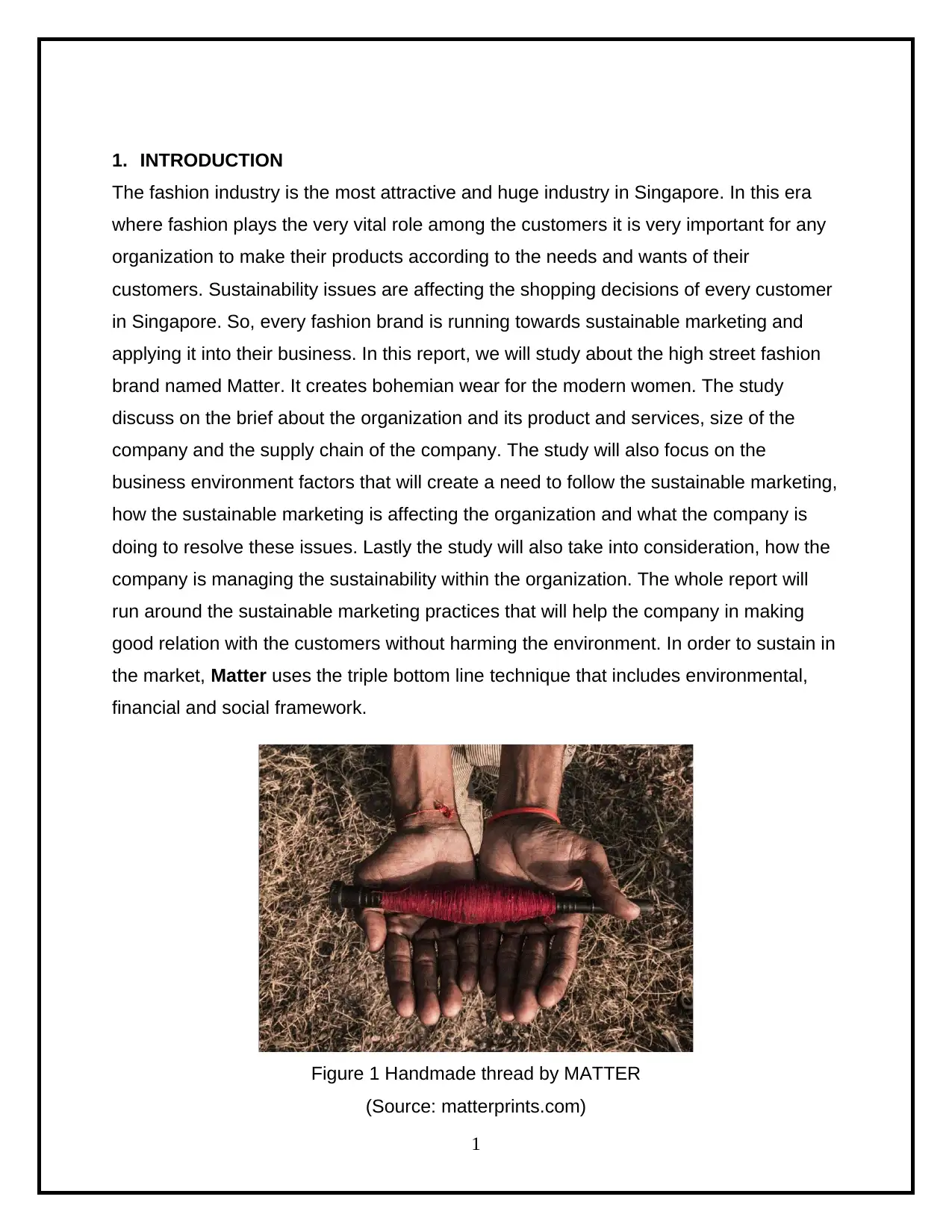
1. INTRODUCTION
The fashion industry is the most attractive and huge industry in Singapore. In this era
where fashion plays the very vital role among the customers it is very important for any
organization to make their products according to the needs and wants of their
customers. Sustainability issues are affecting the shopping decisions of every customer
in Singapore. So, every fashion brand is running towards sustainable marketing and
applying it into their business. In this report, we will study about the high street fashion
brand named Matter. It creates bohemian wear for the modern women. The study
discuss on the brief about the organization and its product and services, size of the
company and the supply chain of the company. The study will also focus on the
business environment factors that will create a need to follow the sustainable marketing,
how the sustainable marketing is affecting the organization and what the company is
doing to resolve these issues. Lastly the study will also take into consideration, how the
company is managing the sustainability within the organization. The whole report will
run around the sustainable marketing practices that will help the company in making
good relation with the customers without harming the environment. In order to sustain in
the market, Matter uses the triple bottom line technique that includes environmental,
financial and social framework.
Figure 1 Handmade thread by MATTER
(Source: matterprints.com)
1
The fashion industry is the most attractive and huge industry in Singapore. In this era
where fashion plays the very vital role among the customers it is very important for any
organization to make their products according to the needs and wants of their
customers. Sustainability issues are affecting the shopping decisions of every customer
in Singapore. So, every fashion brand is running towards sustainable marketing and
applying it into their business. In this report, we will study about the high street fashion
brand named Matter. It creates bohemian wear for the modern women. The study
discuss on the brief about the organization and its product and services, size of the
company and the supply chain of the company. The study will also focus on the
business environment factors that will create a need to follow the sustainable marketing,
how the sustainable marketing is affecting the organization and what the company is
doing to resolve these issues. Lastly the study will also take into consideration, how the
company is managing the sustainability within the organization. The whole report will
run around the sustainable marketing practices that will help the company in making
good relation with the customers without harming the environment. In order to sustain in
the market, Matter uses the triple bottom line technique that includes environmental,
financial and social framework.
Figure 1 Handmade thread by MATTER
(Source: matterprints.com)
1

1.1 Sustainable marketing
The term sustainable marketing consists of two important words; one is sustainable
which means performing activities in such a way so that it does not harm the
environment and this should continue for the long term. The second word, marketing
means to promote the goods and services to create a brand visibility among the
customers (Aguilar.et.al.2016). The term combined together depicts the business
practices of the organization that has been carried out in such a manner which shows to
protect the external atmosphere. It will help in creating the better business opportunities
to the businesses; also helps in creating a good connection with the customers and a
better world.
By following the sustainable business practices will help the business to grow more than
following the normal business practices and attracting more and more customers
towards them. The basic principles of the Sustainable marketing are reduction of the
wastage in the supply chain and making more engagement with the customers. Second,
it is the principle of longevity that means to plan with the long term objective. They have
to forecast the future and plan things accordingly for their operations. Lastly, it is to
focus on the cross promotional activities to promote their business and pace up with fast
speed. To protect the environment from being polluted, management uses the
ecological printing processes that aids the management to easily perform the CSR
activities (Ryals and Macdonald, 2015). To sustain in the market, management needs to
develop the tools and techniques which are useful to protect the environment from
being polluted. Sustainable segmentation of sustainable behavior is done on the basis
of attitude of the customers that facilitates the management to design the product as per
the need of the customers.
2
The term sustainable marketing consists of two important words; one is sustainable
which means performing activities in such a way so that it does not harm the
environment and this should continue for the long term. The second word, marketing
means to promote the goods and services to create a brand visibility among the
customers (Aguilar.et.al.2016). The term combined together depicts the business
practices of the organization that has been carried out in such a manner which shows to
protect the external atmosphere. It will help in creating the better business opportunities
to the businesses; also helps in creating a good connection with the customers and a
better world.
By following the sustainable business practices will help the business to grow more than
following the normal business practices and attracting more and more customers
towards them. The basic principles of the Sustainable marketing are reduction of the
wastage in the supply chain and making more engagement with the customers. Second,
it is the principle of longevity that means to plan with the long term objective. They have
to forecast the future and plan things accordingly for their operations. Lastly, it is to
focus on the cross promotional activities to promote their business and pace up with fast
speed. To protect the environment from being polluted, management uses the
ecological printing processes that aids the management to easily perform the CSR
activities (Ryals and Macdonald, 2015). To sustain in the market, management needs to
develop the tools and techniques which are useful to protect the environment from
being polluted. Sustainable segmentation of sustainable behavior is done on the basis
of attitude of the customers that facilitates the management to design the product as per
the need of the customers.
2
⊘ This is a preview!⊘
Do you want full access?
Subscribe today to unlock all pages.

Trusted by 1+ million students worldwide
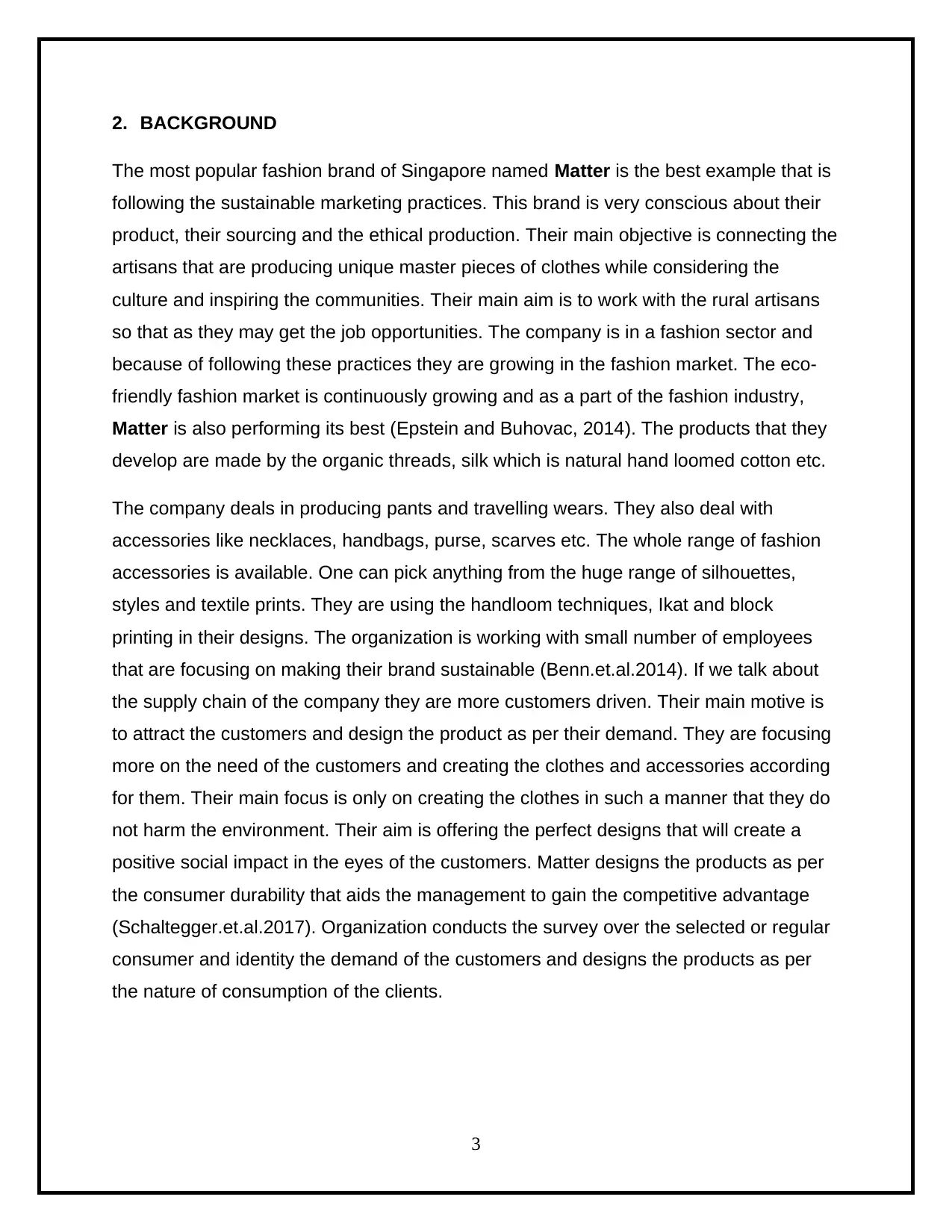
2. BACKGROUND
The most popular fashion brand of Singapore named Matter is the best example that is
following the sustainable marketing practices. This brand is very conscious about their
product, their sourcing and the ethical production. Their main objective is connecting the
artisans that are producing unique master pieces of clothes while considering the
culture and inspiring the communities. Their main aim is to work with the rural artisans
so that as they may get the job opportunities. The company is in a fashion sector and
because of following these practices they are growing in the fashion market. The eco-
friendly fashion market is continuously growing and as a part of the fashion industry,
Matter is also performing its best (Epstein and Buhovac, 2014). The products that they
develop are made by the organic threads, silk which is natural hand loomed cotton etc.
The company deals in producing pants and travelling wears. They also deal with
accessories like necklaces, handbags, purse, scarves etc. The whole range of fashion
accessories is available. One can pick anything from the huge range of silhouettes,
styles and textile prints. They are using the handloom techniques, Ikat and block
printing in their designs. The organization is working with small number of employees
that are focusing on making their brand sustainable (Benn.et.al.2014). If we talk about
the supply chain of the company they are more customers driven. Their main motive is
to attract the customers and design the product as per their demand. They are focusing
more on the need of the customers and creating the clothes and accessories according
for them. Their main focus is only on creating the clothes in such a manner that they do
not harm the environment. Their aim is offering the perfect designs that will create a
positive social impact in the eyes of the customers. Matter designs the products as per
the consumer durability that aids the management to gain the competitive advantage
(Schaltegger.et.al.2017). Organization conducts the survey over the selected or regular
consumer and identity the demand of the customers and designs the products as per
the nature of consumption of the clients.
3
The most popular fashion brand of Singapore named Matter is the best example that is
following the sustainable marketing practices. This brand is very conscious about their
product, their sourcing and the ethical production. Their main objective is connecting the
artisans that are producing unique master pieces of clothes while considering the
culture and inspiring the communities. Their main aim is to work with the rural artisans
so that as they may get the job opportunities. The company is in a fashion sector and
because of following these practices they are growing in the fashion market. The eco-
friendly fashion market is continuously growing and as a part of the fashion industry,
Matter is also performing its best (Epstein and Buhovac, 2014). The products that they
develop are made by the organic threads, silk which is natural hand loomed cotton etc.
The company deals in producing pants and travelling wears. They also deal with
accessories like necklaces, handbags, purse, scarves etc. The whole range of fashion
accessories is available. One can pick anything from the huge range of silhouettes,
styles and textile prints. They are using the handloom techniques, Ikat and block
printing in their designs. The organization is working with small number of employees
that are focusing on making their brand sustainable (Benn.et.al.2014). If we talk about
the supply chain of the company they are more customers driven. Their main motive is
to attract the customers and design the product as per their demand. They are focusing
more on the need of the customers and creating the clothes and accessories according
for them. Their main focus is only on creating the clothes in such a manner that they do
not harm the environment. Their aim is offering the perfect designs that will create a
positive social impact in the eyes of the customers. Matter designs the products as per
the consumer durability that aids the management to gain the competitive advantage
(Schaltegger.et.al.2017). Organization conducts the survey over the selected or regular
consumer and identity the demand of the customers and designs the products as per
the nature of consumption of the clients.
3
Paraphrase This Document
Need a fresh take? Get an instant paraphrase of this document with our AI Paraphraser
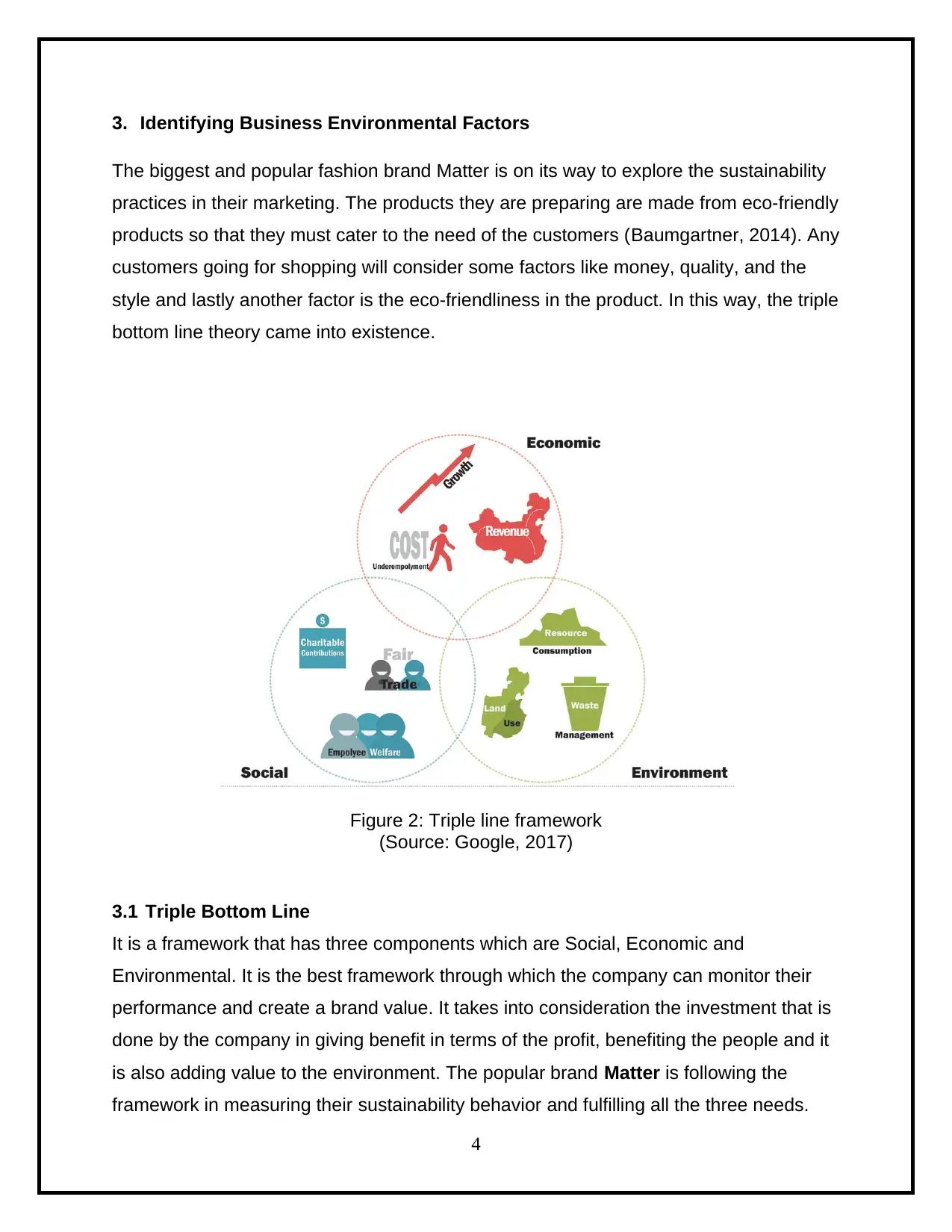
3. Identifying Business Environmental Factors
The biggest and popular fashion brand Matter is on its way to explore the sustainability
practices in their marketing. The products they are preparing are made from eco-friendly
products so that they must cater to the need of the customers (Baumgartner, 2014). Any
customers going for shopping will consider some factors like money, quality, and the
style and lastly another factor is the eco-friendliness in the product. In this way, the triple
bottom line theory came into existence.
Figure 2: Triple line framework
(Source: Google, 2017)
3.1 Triple Bottom Line
It is a framework that has three components which are Social, Economic and
Environmental. It is the best framework through which the company can monitor their
performance and create a brand value. It takes into consideration the investment that is
done by the company in giving benefit in terms of the profit, benefiting the people and it
is also adding value to the environment. The popular brand Matter is following the
framework in measuring their sustainability behavior and fulfilling all the three needs.
4
The biggest and popular fashion brand Matter is on its way to explore the sustainability
practices in their marketing. The products they are preparing are made from eco-friendly
products so that they must cater to the need of the customers (Baumgartner, 2014). Any
customers going for shopping will consider some factors like money, quality, and the
style and lastly another factor is the eco-friendliness in the product. In this way, the triple
bottom line theory came into existence.
Figure 2: Triple line framework
(Source: Google, 2017)
3.1 Triple Bottom Line
It is a framework that has three components which are Social, Economic and
Environmental. It is the best framework through which the company can monitor their
performance and create a brand value. It takes into consideration the investment that is
done by the company in giving benefit in terms of the profit, benefiting the people and it
is also adding value to the environment. The popular brand Matter is following the
framework in measuring their sustainability behavior and fulfilling all the three needs.
4
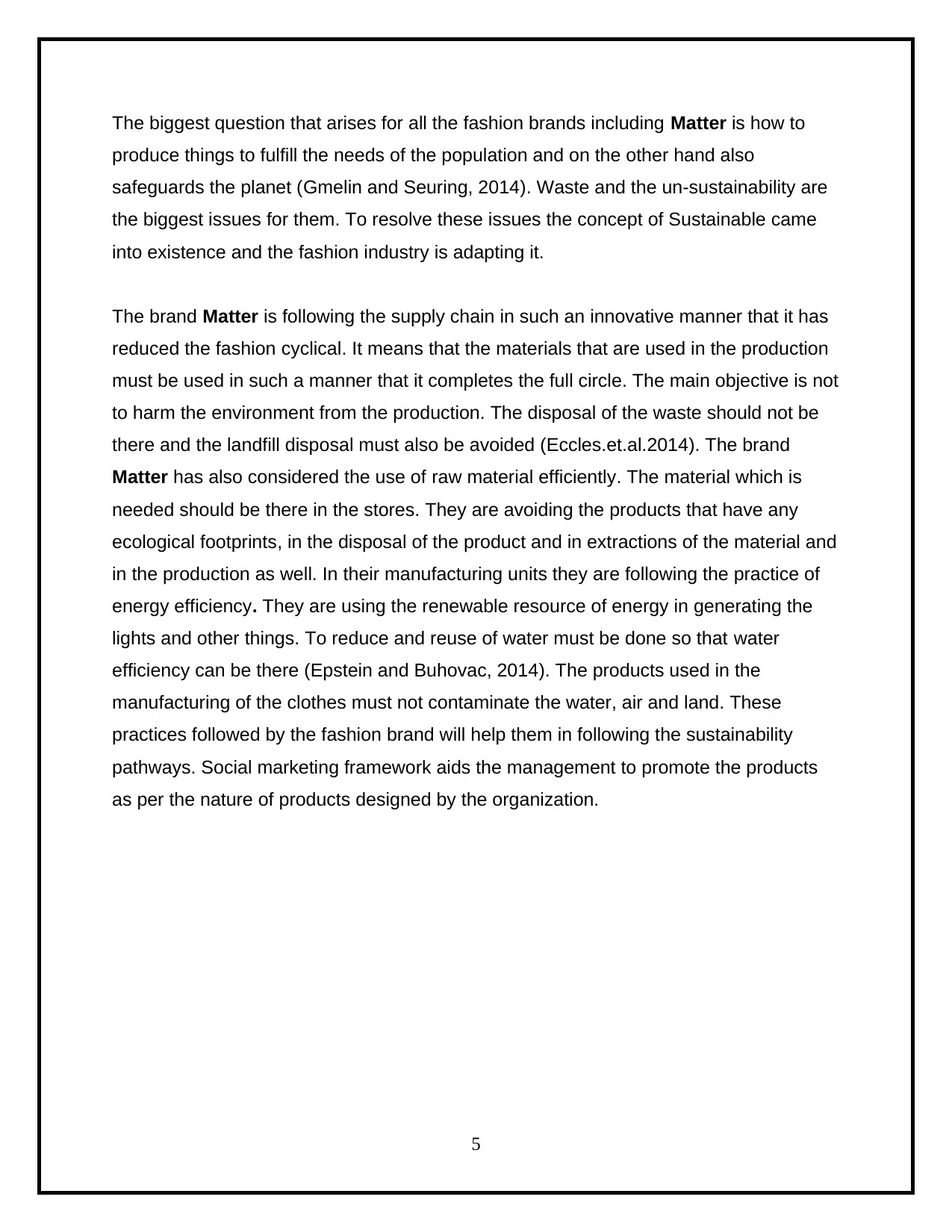
The biggest question that arises for all the fashion brands including Matter is how to
produce things to fulfill the needs of the population and on the other hand also
safeguards the planet (Gmelin and Seuring, 2014). Waste and the un-sustainability are
the biggest issues for them. To resolve these issues the concept of Sustainable came
into existence and the fashion industry is adapting it.
The brand Matter is following the supply chain in such an innovative manner that it has
reduced the fashion cyclical. It means that the materials that are used in the production
must be used in such a manner that it completes the full circle. The main objective is not
to harm the environment from the production. The disposal of the waste should not be
there and the landfill disposal must also be avoided (Eccles.et.al.2014). The brand
Matter has also considered the use of raw material efficiently. The material which is
needed should be there in the stores. They are avoiding the products that have any
ecological footprints, in the disposal of the product and in extractions of the material and
in the production as well. In their manufacturing units they are following the practice of
energy efficiency. They are using the renewable resource of energy in generating the
lights and other things. To reduce and reuse of water must be done so that water
efficiency can be there (Epstein and Buhovac, 2014). The products used in the
manufacturing of the clothes must not contaminate the water, air and land. These
practices followed by the fashion brand will help them in following the sustainability
pathways. Social marketing framework aids the management to promote the products
as per the nature of products designed by the organization.
5
produce things to fulfill the needs of the population and on the other hand also
safeguards the planet (Gmelin and Seuring, 2014). Waste and the un-sustainability are
the biggest issues for them. To resolve these issues the concept of Sustainable came
into existence and the fashion industry is adapting it.
The brand Matter is following the supply chain in such an innovative manner that it has
reduced the fashion cyclical. It means that the materials that are used in the production
must be used in such a manner that it completes the full circle. The main objective is not
to harm the environment from the production. The disposal of the waste should not be
there and the landfill disposal must also be avoided (Eccles.et.al.2014). The brand
Matter has also considered the use of raw material efficiently. The material which is
needed should be there in the stores. They are avoiding the products that have any
ecological footprints, in the disposal of the product and in extractions of the material and
in the production as well. In their manufacturing units they are following the practice of
energy efficiency. They are using the renewable resource of energy in generating the
lights and other things. To reduce and reuse of water must be done so that water
efficiency can be there (Epstein and Buhovac, 2014). The products used in the
manufacturing of the clothes must not contaminate the water, air and land. These
practices followed by the fashion brand will help them in following the sustainability
pathways. Social marketing framework aids the management to promote the products
as per the nature of products designed by the organization.
5
⊘ This is a preview!⊘
Do you want full access?
Subscribe today to unlock all pages.

Trusted by 1+ million students worldwide

Figure 3 Sustainability practices in their marketing
(Source: Google, 2017)
There are various factors that develop the need for sustainability marketing in the
fashion business. There are social, individual and the situational factors. The social
factors such as social norms, cultural values plays key role in adapting the sustainable
marketing. It is very important that the organization put their step forward in saving the
customers from the materials that can harm them. They are following the practices such
as making the clothes from organic threads and other tings so that the customers may
not harm from these things. The society is the one whom we are serving and to keep
them protective is very important (Sánchez, 2015). The use of any harmful materials
may affect the environment. It is very vital to save the planet by adapting to eco-friendly
things.
The next factor comes the individual factors that will take into consideration the personal
values, habits and the lifestyles of an individual, needs, wants, capabilities and skills. In
today’s world the individual are the ones whom the Matter is serving. They are dealing
with apparels and the fashion accessories for both men and women. In today’s world,
anyone who goes for shopping is considering the eco friendliness in the clothes. It is a
trending fashion style among the Singapore’s individuals. Therefore it is very important
for the brand Matter to consider this issue and prepare clothes and dresses and other
6
(Source: Google, 2017)
There are various factors that develop the need for sustainability marketing in the
fashion business. There are social, individual and the situational factors. The social
factors such as social norms, cultural values plays key role in adapting the sustainable
marketing. It is very important that the organization put their step forward in saving the
customers from the materials that can harm them. They are following the practices such
as making the clothes from organic threads and other tings so that the customers may
not harm from these things. The society is the one whom we are serving and to keep
them protective is very important (Sánchez, 2015). The use of any harmful materials
may affect the environment. It is very vital to save the planet by adapting to eco-friendly
things.
The next factor comes the individual factors that will take into consideration the personal
values, habits and the lifestyles of an individual, needs, wants, capabilities and skills. In
today’s world the individual are the ones whom the Matter is serving. They are dealing
with apparels and the fashion accessories for both men and women. In today’s world,
anyone who goes for shopping is considering the eco friendliness in the clothes. It is a
trending fashion style among the Singapore’s individuals. Therefore it is very important
for the brand Matter to consider this issue and prepare clothes and dresses and other
6
Paraphrase This Document
Need a fresh take? Get an instant paraphrase of this document with our AI Paraphraser
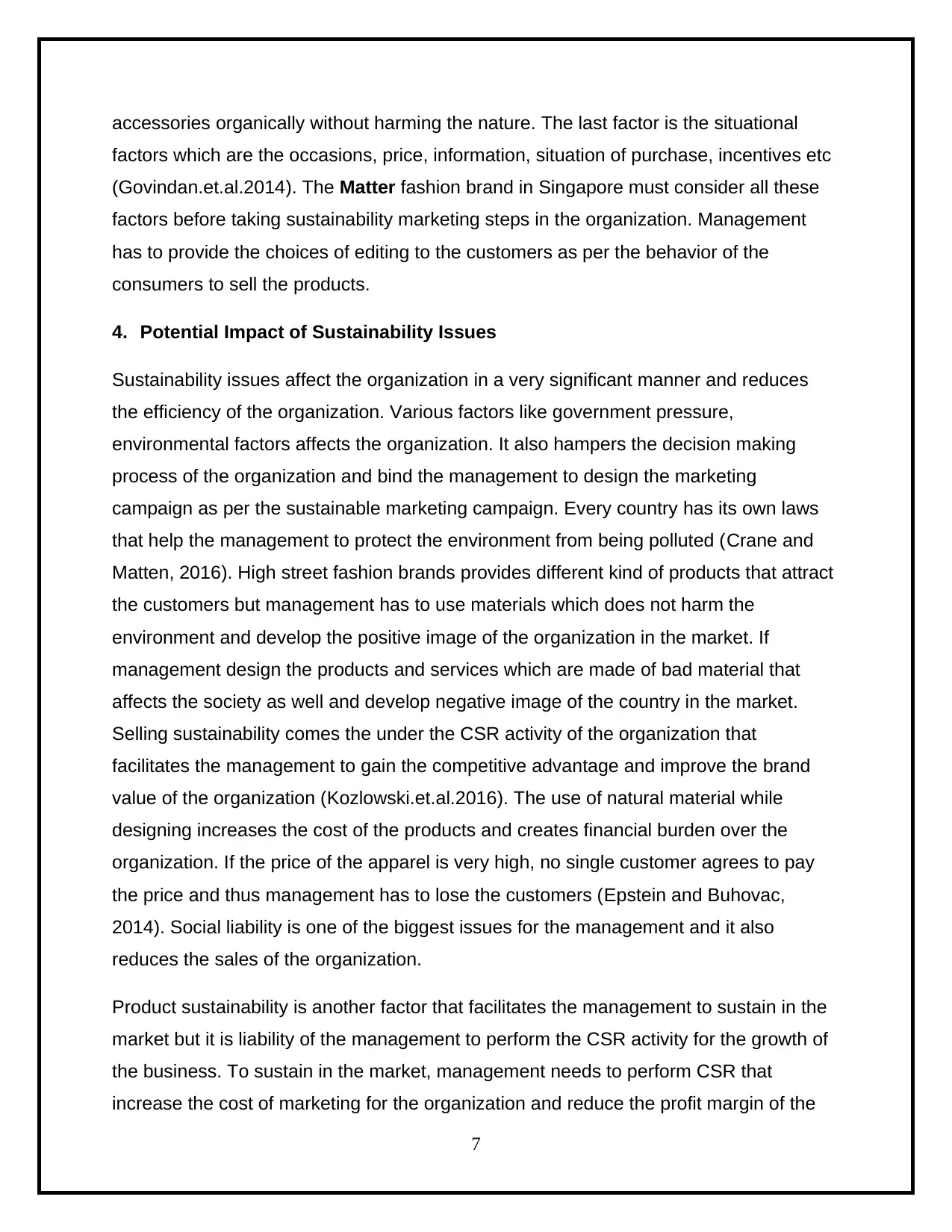
accessories organically without harming the nature. The last factor is the situational
factors which are the occasions, price, information, situation of purchase, incentives etc
(Govindan.et.al.2014). The Matter fashion brand in Singapore must consider all these
factors before taking sustainability marketing steps in the organization. Management
has to provide the choices of editing to the customers as per the behavior of the
consumers to sell the products.
4. Potential Impact of Sustainability Issues
Sustainability issues affect the organization in a very significant manner and reduces
the efficiency of the organization. Various factors like government pressure,
environmental factors affects the organization. It also hampers the decision making
process of the organization and bind the management to design the marketing
campaign as per the sustainable marketing campaign. Every country has its own laws
that help the management to protect the environment from being polluted (Crane and
Matten, 2016). High street fashion brands provides different kind of products that attract
the customers but management has to use materials which does not harm the
environment and develop the positive image of the organization in the market. If
management design the products and services which are made of bad material that
affects the society as well and develop negative image of the country in the market.
Selling sustainability comes the under the CSR activity of the organization that
facilitates the management to gain the competitive advantage and improve the brand
value of the organization (Kozlowski.et.al.2016). The use of natural material while
designing increases the cost of the products and creates financial burden over the
organization. If the price of the apparel is very high, no single customer agrees to pay
the price and thus management has to lose the customers (Epstein and Buhovac,
2014). Social liability is one of the biggest issues for the management and it also
reduces the sales of the organization.
Product sustainability is another factor that facilitates the management to sustain in the
market but it is liability of the management to perform the CSR activity for the growth of
the business. To sustain in the market, management needs to perform CSR that
increase the cost of marketing for the organization and reduce the profit margin of the
7
factors which are the occasions, price, information, situation of purchase, incentives etc
(Govindan.et.al.2014). The Matter fashion brand in Singapore must consider all these
factors before taking sustainability marketing steps in the organization. Management
has to provide the choices of editing to the customers as per the behavior of the
consumers to sell the products.
4. Potential Impact of Sustainability Issues
Sustainability issues affect the organization in a very significant manner and reduces
the efficiency of the organization. Various factors like government pressure,
environmental factors affects the organization. It also hampers the decision making
process of the organization and bind the management to design the marketing
campaign as per the sustainable marketing campaign. Every country has its own laws
that help the management to protect the environment from being polluted (Crane and
Matten, 2016). High street fashion brands provides different kind of products that attract
the customers but management has to use materials which does not harm the
environment and develop the positive image of the organization in the market. If
management design the products and services which are made of bad material that
affects the society as well and develop negative image of the country in the market.
Selling sustainability comes the under the CSR activity of the organization that
facilitates the management to gain the competitive advantage and improve the brand
value of the organization (Kozlowski.et.al.2016). The use of natural material while
designing increases the cost of the products and creates financial burden over the
organization. If the price of the apparel is very high, no single customer agrees to pay
the price and thus management has to lose the customers (Epstein and Buhovac,
2014). Social liability is one of the biggest issues for the management and it also
reduces the sales of the organization.
Product sustainability is another factor that facilitates the management to sustain in the
market but it is liability of the management to perform the CSR activity for the growth of
the business. To sustain in the market, management needs to perform CSR that
increase the cost of marketing for the organization and reduce the profit margin of the
7
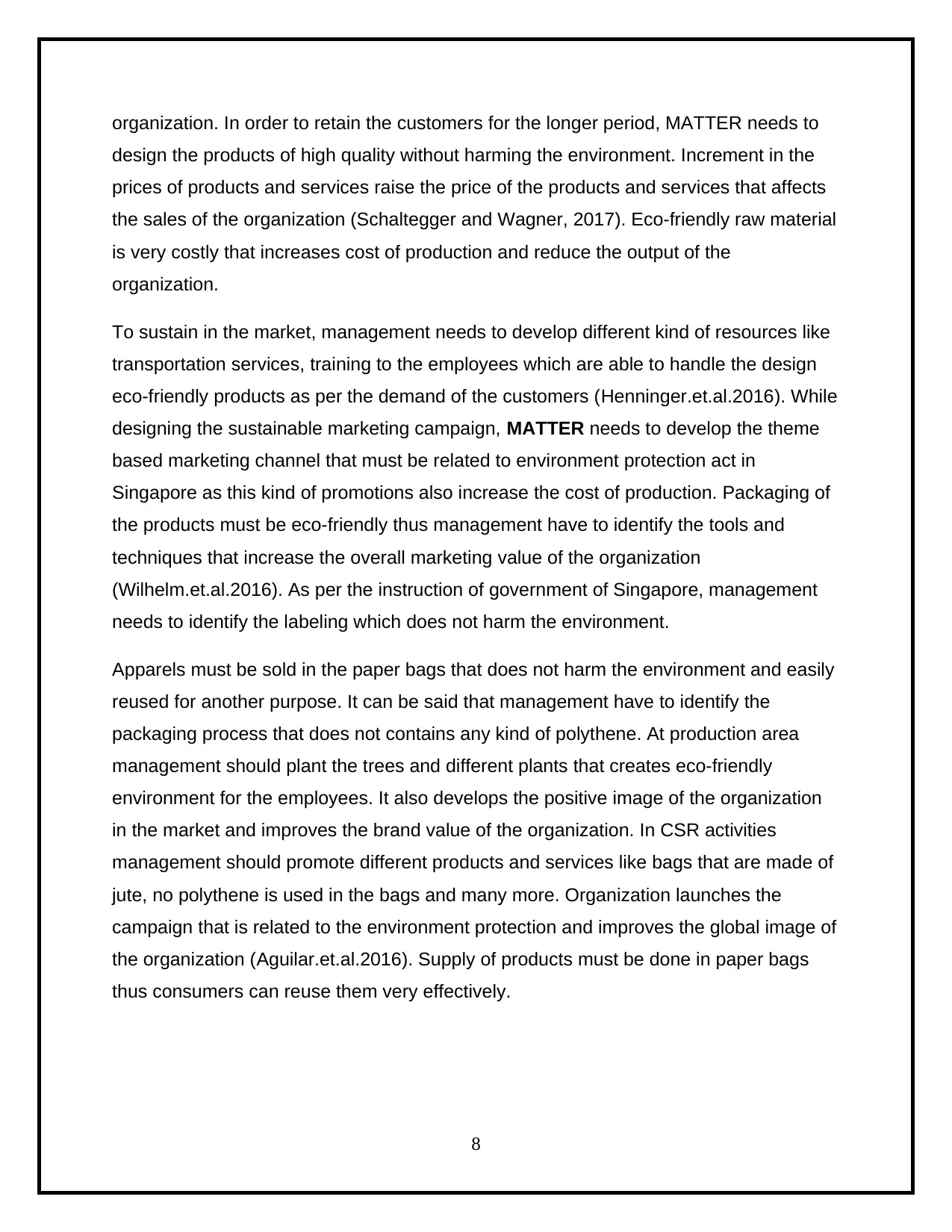
organization. In order to retain the customers for the longer period, MATTER needs to
design the products of high quality without harming the environment. Increment in the
prices of products and services raise the price of the products and services that affects
the sales of the organization (Schaltegger and Wagner, 2017). Eco-friendly raw material
is very costly that increases cost of production and reduce the output of the
organization.
To sustain in the market, management needs to develop different kind of resources like
transportation services, training to the employees which are able to handle the design
eco-friendly products as per the demand of the customers (Henninger.et.al.2016). While
designing the sustainable marketing campaign, MATTER needs to develop the theme
based marketing channel that must be related to environment protection act in
Singapore as this kind of promotions also increase the cost of production. Packaging of
the products must be eco-friendly thus management have to identify the tools and
techniques that increase the overall marketing value of the organization
(Wilhelm.et.al.2016). As per the instruction of government of Singapore, management
needs to identify the labeling which does not harm the environment.
Apparels must be sold in the paper bags that does not harm the environment and easily
reused for another purpose. It can be said that management have to identify the
packaging process that does not contains any kind of polythene. At production area
management should plant the trees and different plants that creates eco-friendly
environment for the employees. It also develops the positive image of the organization
in the market and improves the brand value of the organization. In CSR activities
management should promote different products and services like bags that are made of
jute, no polythene is used in the bags and many more. Organization launches the
campaign that is related to the environment protection and improves the global image of
the organization (Aguilar.et.al.2016). Supply of products must be done in paper bags
thus consumers can reuse them very effectively.
8
design the products of high quality without harming the environment. Increment in the
prices of products and services raise the price of the products and services that affects
the sales of the organization (Schaltegger and Wagner, 2017). Eco-friendly raw material
is very costly that increases cost of production and reduce the output of the
organization.
To sustain in the market, management needs to develop different kind of resources like
transportation services, training to the employees which are able to handle the design
eco-friendly products as per the demand of the customers (Henninger.et.al.2016). While
designing the sustainable marketing campaign, MATTER needs to develop the theme
based marketing channel that must be related to environment protection act in
Singapore as this kind of promotions also increase the cost of production. Packaging of
the products must be eco-friendly thus management have to identify the tools and
techniques that increase the overall marketing value of the organization
(Wilhelm.et.al.2016). As per the instruction of government of Singapore, management
needs to identify the labeling which does not harm the environment.
Apparels must be sold in the paper bags that does not harm the environment and easily
reused for another purpose. It can be said that management have to identify the
packaging process that does not contains any kind of polythene. At production area
management should plant the trees and different plants that creates eco-friendly
environment for the employees. It also develops the positive image of the organization
in the market and improves the brand value of the organization. In CSR activities
management should promote different products and services like bags that are made of
jute, no polythene is used in the bags and many more. Organization launches the
campaign that is related to the environment protection and improves the global image of
the organization (Aguilar.et.al.2016). Supply of products must be done in paper bags
thus consumers can reuse them very effectively.
8
⊘ This is a preview!⊘
Do you want full access?
Subscribe today to unlock all pages.

Trusted by 1+ million students worldwide
1 out of 17
Related Documents
Your All-in-One AI-Powered Toolkit for Academic Success.
+13062052269
info@desklib.com
Available 24*7 on WhatsApp / Email
![[object Object]](/_next/static/media/star-bottom.7253800d.svg)
Unlock your academic potential
Copyright © 2020–2026 A2Z Services. All Rights Reserved. Developed and managed by ZUCOL.




